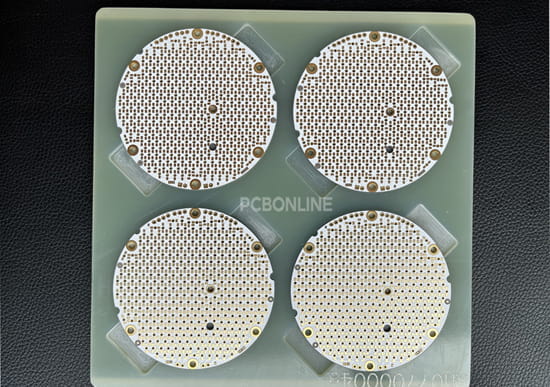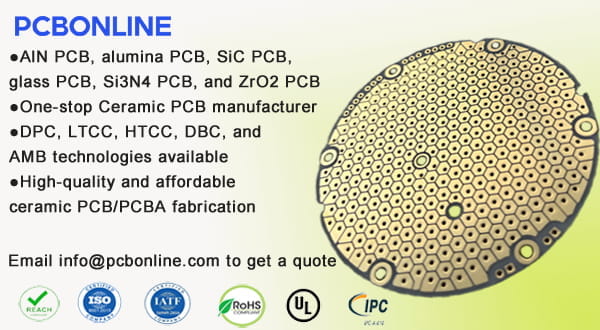LTCC is a ceramic electronics technology used for ceramic PCB/PCBA fabrication. Those LTCC ceramic PCB/PCBA or modules are used in radio-frequency (RF), microwave-frequency, and millimeter wave frequency applications in aerospace, automotive, communication, power, optical communication, and so on fields.

What is the LTCC Ceramic PCB Technology
LTCC, developed from the HTCC (high-temperature co-fired ceramic) technology in 1982, is a multilayer low-temperature ceramic PCB manufacturing technology. In ceramic PCB fabrication, the ceramic substrate should be bonded with copper layers. Low temperatures mean bonding the ceramic substrate and copper clad under 1000℃.

The ceramic materials for LTCC ceramic PCBs include glass-ceramic materials, glass + ceramic composite materials, and amorphous glass materials. Amorphous glass, crystallized glass, and low melting point oxide are added to the ceramic substrate material to boost sintering. The metal for the circuit layers is not only copper, but it can also be silver, gold, and alloys such as Ag-Pd, Ag-Pt, and Au-Pt.
The LTCC ceramic PCB manufacturing process is:
- First, the ceramic cast belt is in the precise thickness and cut into pieces in the required width.
- Laser drill vias on the ceramic pieces.
- Via copper filling by injecting liquid copper in the silkscreen printing method.
- Print precision conductive paste to form the circuit images.
- Place passive components between the circuit layers.
- Laminate the ceramic PCB layers.
- Sinter the three-dimensional ceramic PCB at about 900℃.
- Apply solder masks and silkscreen on the ceramic PCB.
- Mount active components by wire-bonding or SMT on the LTCC ceramic PCB.
- Finally, conduct functional testing on the finished LTCC ceramic PCBA module.
Before lamination and sintering, the LTCC ceramic PCB manufacturer PCBONLINE will check every PCB layer to ensure the PCB quality and yield rate.
What Applications Can LTCC Ceramic PCBs Apply to?

The LTCC ceramic technology can fabricate multilayer ceramic PCBs in three-dimensional design. It allows high-density circuits with a delicate trace space/width and reduces the product's size. LTCC ceramic PCBs have good conductivity, low dielectric constant, and low dielectric loss, so they are suitable for RF, microwave, and millimeter wave devices. LTCC ceramic technology can be used to manufacture electronic components and integrate them with front-end modules.
You can use LTCC ceramic PCBs in the following ways:
- Automotive electronics - LTCC ceramic PCBs can be used in all kinds of automotive sensors, such as voltage sensors, pressure sensors, and radar sensors. The ignition coils, inverter, water pump, and oil pump also use LTCC ceramic PCBs. Besides, LTCC ceramic PCBs also find applications in electronic shift and the air conditioning system of electronic vehicles.
- Communications electronics - LTCC ceramic PCBs are suitable for communications devices. Bluetooth modules, smartphone front-end modules, centralized parameter circulators, transmitter/receiver modules, antenna switch modules, and power amplifier modules use LTCC ceramic PCBs.
- Custom electronic component fabrication - LTCC ceramic technology allows passive components embedded. For this reason, you can use this technology to customize ceramic resistors, capacitors, resistors, filters, duplexers, antennas, baluns, couplers, power splitters, and common mode chokes.
- Other fields - LTCC is a low-cost packaging technology that enables the product to be thinner, lighter, and smaller. You can use LTCC ceramic PCBs for car refrigerators, red wine shelves, and hair removal devices, facial cleansers for beauty.
LTCC Ceramic PCB vs HTCC Ceramic PCB
LTCC is developed from HTCC. What are the differences between LTCC ceramic PCBs and HTCC ceramic PCBs? Please check out the below.
- Different temperature requirements: LTCC requires sintering temperatures between 800℃ to 950℃. HTCC requires 1650℃ to 1850℃.
- Different ceramic substrate materials: LTCC ceramic materials are glass-ceramic materials, glass + ceramic composite materials, and amorphous glass materials. HTCC ceramic materials are aluminum nitride (AlN), aluminum oxide (alumina, or Al₂O₃), or mullite without glass.
- Different metals: LTCC ceramic PCBs' conductive layers use high conductivity materials with low melting points, such as Ag, Cu, Au, and their alloys. HTCC ceramic PCBs use refractory metal materials with poor conductivity, such as tungsten, molybdenum, and manganese.
- Different features and applications: LTCC ceramic PCBs HTCC have high speed, high wiring density, and low dielectric loss. They are mainstream PCBs for passive integration circuits, and they are popular for high-frequency and high-speed circuits. HTCC ceramic PCBs have strong structural strength, high thermal conductivity, good chemical stability, and high wiring density. They are popular for high-power microassembled circuits, high-reliability microelectronic integrated circuits, and automotive high-power circuits.
High-Quality One-Stop Ceramic PCB Manufacturer - PCBONLINE
PCBONLINE is a ceramic PCB source factory manufacturer, providing LTCC, HTCC, DPC, DBC, and AMB ceramic PCBs. Ceramic PCBs of the AlN, Al₂O₃, SiC, Si₃N₄, and glass-ceramic are available to fabricate and assemble at one stop.

You can check ceramic PCB fabrication capabilities from PCBONLINE below:
- Ceramic PCB size: Due to the warping problem, ceramic PCBs have a maximum size limit. From PCBONLINE, the maximum PCB panel size/1 × 2 is 138mm × 190mm. For extreme prototypes, the max size is 160mm × 280mm. Regular ceramic PCB panel sizes/1 × 2 are 114mm × 114mm, 120mm × 130mm, 132mm × 142mm, and 138mm × 190mm. Note: Please leave a 4mm-5mm space for edge rails.
- Ceramic PCB thickness: From PCBONLINE, the ceramic PCB thickness range is 0.25mm to 4.1mm, and the ceramic thickness range is 0.15mm to 4.0mm. The regular ceramic thicknesses are 0.25mm, 0.381mm, 0.5mm, 0.635mm, 0.762mm, 0.8mm, 0.89mm, 1.0mm, 1.2mm, 1.5mm, 2.0mm, 3.0mm, and 4.0mm.
- Ceramic PCB copper thickness: arbitrarily from 10nm to 300μm for DPC ceramic PCBs. Regular 6μm to 8μm for LTCC ceramic PCBs, and it can reach 10μm to 12μm for extreme prototypes.
- Impedance tolerance: ±0.05%
By working with PCBONLINE, you can enjoy these benefits:
- One-stop ceramic PCB fabrication, PCB assembly, and box-build assembly from prototypes to bulky production.
- High-quality ceramic PCBs with a reasonable yield rate and excellent solderability.
- Ceramic PCBs can be single-sided, double-sided, and from 1 to 4 layers.
- Free PCB design assistance for cost optimization without quality/function sacrifice.
- One-on-one engineering support throughout your project.
PCBONLINE is certified with ISO 9001:2015, IATF 16949, REACH, RoHS, and UL. If you feel interested in having ceramic PCBs fabricated from PCBONLINE, feel free to send your inquiry by email to info@pcbonline.com. We will reply to you with a quotation as soon as possible.
Conclusion
LTCC ceramic technology is used for glass-ceramic ceramic PCB manufacturing with lower temperatures and saves costs. LTCC ceramic PCBs are mainstream for passive integration circuits and also popular for high-frequency/high-speed applications. If you have doubts about LCTT ceramic PCB fabrication and assembly, chat with us from the online chat window on the right.




